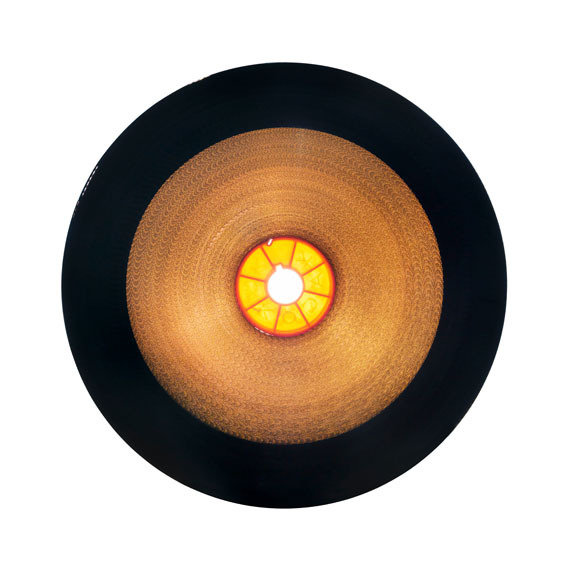Reiner Riedler
dal 8/5/2014 al 20/6/2014
Segnalato da
8/5/2014
Reiner Riedler
Gallery Hengevoss-Durkop, Hamburg
The Unseen Seen. The photographer presents portraits pertaining to popular movies, but he has depicted the film reels of the movies in question in their materiality as such.

The Discovery of the Film Reel Portrait
The portrait is one of the traditional genres in the history of art, which has never lost its pertinence. The Viennese photographer Reiner Riedler confronts us with a very intriguing type of portrait. He presents to us portraits pertaining to popular movies that all of us are familiar with, such as Michael Curtiz’s Casablanca (1942), Josef Sternberg’s The Blue Angel (1930), and Federico Fellini’s Ginger and Fred (1986). However, the artist has not chosen a significant frame or created a compilation of various scenes, but has rather depicted the film reels of the movies in question in their materiality as such.
We thus see luminous, often multi-colored discs with hatched or grainy, fragile, circular lines that proceed to an inner zone through the midst of which light can freely enter as through an ocular lens. The partially striking similarity to an eye’s iris personalizes, mystifies, and imbues the representation with a peculiar aliveness. The latter effect is still enhanced in view of the titles of the films. The cool bluish shimmer of Don Hewitt’s See it now: A Conversation with J. Robert Oppenheimer (1955) evokes before our inner eye the image of Marlene Dietrich, with whom this conversation was conducted. The bright yellow of Alice in Wonderland (1951), which forms a contrast to a dark, shadowed ring and bars, recalls the magical, fairytale mysticism of this film. The blackness rendered in the case of Nosferatu takes up the horror and the nocturnal darkness in the film of Friedrich Wilhelm Murnau (1922). The warm, golden beige, green, and red as well as the coarser, cord-like lines of Fitzcarraldo (1982) are reminiscent of the jungle in Werner Herzog’s famous movie. The strangely individual aesthetic that seems to correspond so closely to the characteristics of the given films, is a result of Reiner Riedler’s technique of backlighting the film reels with white light before photographing them. The portraits appear to have a soul of their own; the photographer has rendered the invisible visible.
The project was realized in collaboration with the film archivist Volker Ernst. All of the depicted film reels stem from the archives of the Deutsche Kinemathek in Berlin. One of the central concepts it conveys, in which presumably the emergence of the portrait as such is also rooted, is the notion that one might counter the transience of the collected films and keep their memory alive. The film material, which often consists of celluloid or cellulose acetate, the former of which is also easily inflammable and can only be stored in cool places, slowly dissolves in the process of aging.
A catalogue has been published in conjunction with the exhibition. Till April 27 the serie has been shown in Deutschen Kinemathek. Museum für Film und Fernsehen in Berlin“.
Image: Josef von Sternberg, Der Blaue Engel, Germany 1930, positive, cellulose acetate, polyester, 35 mm 60 x 60 cm oder 100 x100 cm, Pigmentdruck / Acryl / Aludibond, 2014, je Ed. 5 + 2Ap
Opening reception in the presence of the artist: Friday, May 9, 2014, 6-10 pm
Gallery Weekend in the Kontorhaus district, Hamburg.
Galerie Hengevoss-Dürkop
Klosterwall 13, 20095 Hamburg
Hours:
Wed-Fri 1-7pm, Sat 12-3pm



